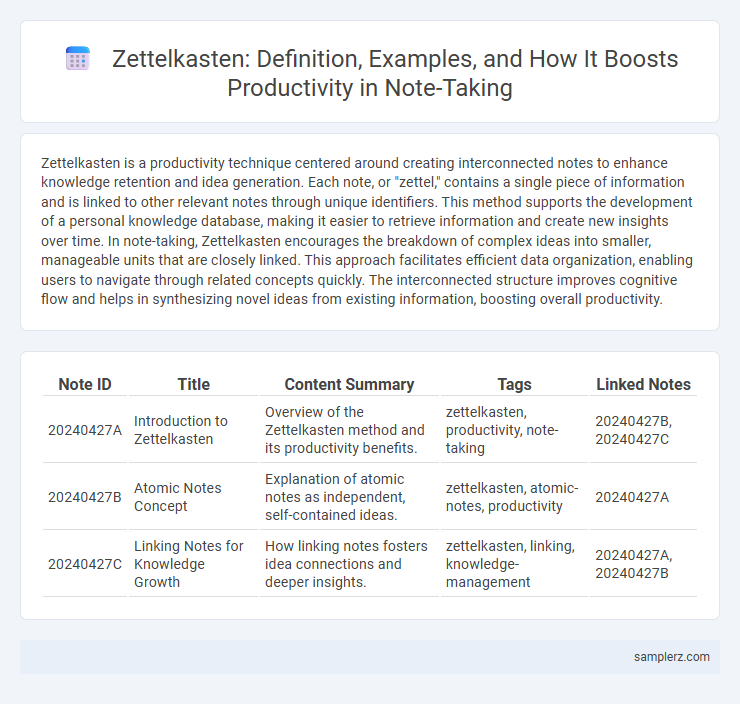Zettelkasten is a productivity technique centered around creating interconnected notes to enhance knowledge retention and idea generation. Each note, or "zettel," contains a single piece of information and is linked to other relevant notes through unique identifiers. This method supports the development of a personal knowledge database, making it easier to retrieve information and create new insights over time. In note-taking, Zettelkasten encourages the breakdown of complex ideas into smaller, manageable units that are closely linked. This approach facilitates efficient data organization, enabling users to navigate through related concepts quickly. The interconnected structure improves cognitive flow and helps in synthesizing novel ideas from existing information, boosting overall productivity.
Table of Comparison
| Note ID | Title | Content Summary | Tags | Linked Notes |
|---|---|---|---|---|
| 20240427A | Introduction to Zettelkasten | Overview of the Zettelkasten method and its productivity benefits. | zettelkasten, productivity, note-taking | 20240427B, 20240427C |
| 20240427B | Atomic Notes Concept | Explanation of atomic notes as independent, self-contained ideas. | zettelkasten, atomic-notes, productivity | 20240427A |
| 20240427C | Linking Notes for Knowledge Growth | How linking notes fosters idea connections and deeper insights. | zettelkasten, linking, knowledge-management | 20240427A, 20240427B |
Introduction to Zettelkasten Note-Taking
The Zettelkasten method enhances productivity by creating a network of interconnected notes that mimic natural thinking patterns. Each note, or "zettel," contains a single idea and links to related notes, fostering deeper understanding and easy retrieval. This approach transforms scattered information into a dynamic knowledge system, boosting learning and creativity.
How Zettelkasten Boosts Productivity
Zettelkasten enhances productivity by transforming scattered notes into a dynamic, interconnected knowledge network that promotes efficient idea retrieval and synthesis. Each note, or "zettel," is linked contextually, enabling users to uncover relationships and develop complex thoughts rapidly. This method streamlines creative workflows, reduces cognitive load, and accelerates the generation of insights across projects.
Key Components of a Zettelkasten Note
A Zettelkasten note consists of a unique ID, a concise atomic idea, and clear links to related notes, enabling efficient retrieval and connection of knowledge. Each note captures a single concept in precise language to enhance understanding and minimize cognitive overload. This structure facilitates a dynamic, interconnected knowledge base that improves long-term retention and creative thinking.
Example Workflow: Creating a Zettelkasten Note
Creating a Zettelkasten note involves breaking down complex ideas into atomic, interconnected notes that capture a single concept per slip. Each note is assigned a unique ID and linked to related notes through explicit references, enhancing knowledge retrieval and idea synthesis. This workflow improves productivity by fostering a dynamic, evolving knowledge base tailored for efficient research and creative problem-solving.
Linking Ideas: Practical Zettelkasten Note Example
A practical Zettelkasten note links ideas by assigning unique IDs to each concept, such as "20240427A" for a productivity tip, and referencing related notes like "20240420B" on time management. This method creates a dense network of interconnected notes, enhancing recall and sparking new insights through associative thinking. By continuously linking relevant ideas, the Zettelkasten system transforms isolated notes into a cohesive knowledge web.
Tagging and Categorization in Zettelkasten Notes
Tagging and categorization in Zettelkasten notes enhance information retrieval by associating each note with relevant keywords and thematic clusters, creating a dense network of interconnected ideas. This method transforms isolated notes into a dynamic knowledge graph where related concepts are easily traceable through semantic links. Effective use of tags and categories accelerates the synthesis of new insights by facilitating cross-referencing and contextual understanding within the Zettelkasten system.
Using Zettelkasten Notes for Project Management
Using Zettelkasten notes for project management enhances task organization and idea synthesis by linking related concepts through unique IDs, fostering better project overview and cross-referencing. This method enables quick retrieval of critical information, ensuring efficient progress tracking and decision-making. Integrating Zettelkasten into project workflows improves clarity and supports scalable project documentation.
Digital vs Physical Zettelkasten: Note Examples
Digital Zettelkasten systems leverage searchable tagging, hyperlinking, and cloud storage to organize notes efficiently, allowing rapid retrieval and cross-referencing across vast databases. Physical Zettelkasten employs index cards and manual categorization, fostering tactile engagement and a linear, chronological development of ideas. Both methods prioritize atomic, context-rich notes, but digital platforms often integrate multimedia, automation, and backup, enhancing scalability and collaboration for productivity workflows.
Integrating Zettelkasten Notes with Productivity Apps
Integrating Zettelkasten notes with productivity apps like Obsidian or Notion enhances workflow by linking ideas through bidirectional links and tags, enabling seamless navigation and context retrieval. This combination supports efficient knowledge management by syncing daily tasks with related notes, boosting both organization and insight generation. Leveraging API integrations further automates note capture and categorization, optimizing productivity and cognitive output.
Best Practices for Effective Zettelkasten Notes
Effective Zettelkasten notes emphasize atomicity by capturing a single idea per note to enhance clarity and retrieval. Consistent use of meaningful tags and backlinks creates a semantic network that facilitates connections between concepts. Regularly reviewing and refining notes ensures accuracy and keeps the knowledge base relevant and usable over time.

example of Zettelkasten in note Infographic
 samplerz.com
samplerz.com